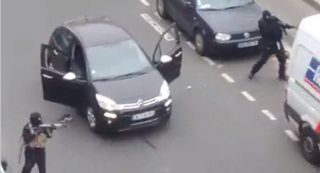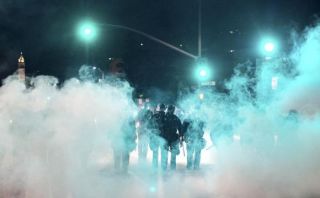Environment
Je Suis Ferguson?
What Charlie Hebdo and Ferguson, Missouri tell us about human nature
Posted February 8, 2015
As the modern day Thomas Paine, Jon Stewart so eloquently stated, “2014 was not a great year for people.” 2014 saw Ebola devastate populations in West Africa and make it to the U.S. and Europe; a petulant, hypersensitive dictator try to stop a Hollywood movie from being seen; and refugees in South Sudan flee by the thousands from the violence that overwhelmed the world’s youngest country. This past year, the world watched as ISIL terrorized an entire region – a situation that has only intensified over the past few months; Russia illegally invaded a sovereign nation; and police killed unarmed black civilians in the streets and parks of America’s cities, on our sidewalks, and in Walmart.
The protests that resulted from the police killings in the U.S. reopened a wound that has never healed. Many were left facing the realization that the “post-racial” society they thought they lived in was a fragile house of cards, a liberal dream. For some, their daily realities of dealing with authority and power in this country were plastered across television sets and computer monitors. Still more were shaken to their cores by the militarization of police forces across the country and the seemingly casual administration of lethal force on American citizens. For still others, their feelings about members of other “races” seemed to be justified: black people were thugs who were looking for reasons to break the law, while white people were belligerent racists who had no concern for the well-being of people of color.
The world watched as citizens in Ferguson and across the U.S. took to the streets in protest of what they perceived as the unjust killings of their fellow Americans, only to be ridiculed by so-called news outlets, and attacked by police who resembled military units more than community peacekeepers. While some leaders have tried to bring various parties together and have urged all Americans to confront our collective demons and deal with the systemic inequalities that exist in our culture; tension, vitriol, and chaos have ruled the day so far. The killings of predominantly black citizens by predominantly white police, the intensity of the reaction by police and their supporters to the protests, and the willingness of both sides to resort to violence have led many to ask if it is, “…due to something innate in our human nature?”
On January 7, 2015, 4,300 miles from Ferguson, Missouri, humanity and civilization took another collective blow. When terrorists attacked the offices of Charlie Hebdo, killing twelve people, we were faced, once again with a human tragedy, and forced to examine why some are so willing to kill over cultures, beliefs, or the color of skin. On the surface, it may appear that the Charlie Hebdo attack and the lethal force used by police in the U.S. have little in common beyond the presence of men with guns. After all, the officers involved in the shootings and chokings were enforcing the law as they saw fit in the moment, and there is little or no evidence that they were targeting the individuals they killed. The terrorists targeted employees of Charlie Hebdo because of the inflammatory cartoons and commentary, directed at the Islamic prophet Mohammed the publication produced. The two police officers, the maintenance worker, and the visitor who were killed during the attack were collateral damage.
While I would never equate police officers, the majority of who serve their communities with honor, respect, and courage, with terrorists, the underlying foundations for their actions share a connection, buried deep in our evolutionary history. They are both rooted in human nature.
“Nature” is a charged term, and there are those who falsely equate “nature” or “natural” with inevitable, pre-determined, or blameless. When I, and many others use the term “natural” or talk about the “nature” of a species, we are referring to species typical traits that regularly develop and are observed in wild, or natural populations. Extending those criteria to humans, we can record and study traits that regularly develop and are observed across human cultures, and are therefore species typical. A trait that is part of human nature is not inevitable, pre-determined, or blameless. A trait that is part of human nature is typical for our species and can be observed across multiple cultures. By capitulating with apologists, who twist the meaning of scientific terms to advance their own agendas, we are allowing non-scientists to frame the discussion, and we end up ignoring important data – data about our nature as a species.
Humans naturally form in-groups, and treat outsiders with suspicion, mistrust and hostility. We are by our nature, xenophobes. In-groups and xenophobia are why soldiers are willing to die for each other and kill other humans, and why violence can so easily erupt during athletic events. To use an overused phrase, in-groups and xenophobia are “part of our DNA.” We do not need to be taught to form in-groups, or to act aggressively to outsiders.
We only need to be taught which groups to join, and who doesn’t belong.
The killing of individuals from one group by males from other groups, especially when there is an imbalance of power and a perceived threat is part of human nature. It cuts across time, cultures, and circumstances and is, unfortunately, part of our history, and our present as a species. In this context the tragedies in France and the United States are not surprising; in fact, they are predictable, and they are fueled by the same basal behavioral responses.
Young men are driven to join, and be accepted into groups, often at great personal risk. This drive is the result of evolutionary pressures on human and hominin populations, over millennia for males to form alliances with each other. Those alliances take place between individuals, and aid in competition within a group, but there is another level of bonding that is necessary for groups to collectively battle each other. Human males, much like bottlenose dolphins and our chimpanzee cousins, form “second level” or “super alliances” that result in more than three males from an in-group being bonded against all the males from an out-group.
The men who attacked the headquarters of Charlie Hebdo, identified as members of a specific in-group, Al Qaeda, and they saw everyone else as an outsider. They saw the Charlie Hebdo employees as the enemy, they were compelled by the leaders of their in-group to take action against them, and they were provided with the training and firepower to create a significant imbalance of power. It has been reported that the gunmen had AK-47-type assault rifles, submachine guns, Tokarev pistols, a Rocket propelled grenade, and a shotgun. The potential rewards for their actions would be full acceptance into the group, as heroes, and potentially martyrs. Beyond the worldly rewards, the perpetrators were told to expect what all male martyrs of Islam receive, seventy-two virgins waiting for them in paradise upon their deaths.
The attackers were told which group they belonged to, who weren’t members of that group, and sent on their mission to act in irrational fearful ways of the “other.”
The police officers involved in the lethal attacks in the U.S. were all members of an in-group that has become more and more distinct over the past twenty years. While S.W.A.T. teams and other special tactical units have existed for decades in large city police departments, the demand for a more militarized police force took hold in the consciousness of America on February 28, 1997 in North Hollywood, California. Two patrolmen happened on a bank robbery at around 9:15 a.m. and were met by two perpetrators in full body armor, carrying military style assault rifles and sidearms. The first officers on the scene, and their immediate backup were hopelessly outgunned in a standoff that lasted over forty minutes that resulted in 6 civilians and 10 police officers being injured, both perpetrators being killed, and created a seismic shift in how the public viewed the arming of police in America.
One of the unfortunate by-products of the militarization of police in our country has been the isolation of them as a distinct group. The officers who killed those young citizens saw themselves as members of “police culture” and different from the general public. This attitude is widespread among police, at all levels, and often encouraged at the most basic level. The enculturation of cadets into a “fraternal” order, and the resultant “blue shield” is extremely effective. In fact, only the in-groups observed in military units rival the in-groups among police. What we saw in the form of protests across the United States in the Fall and Winter of 2014 was the formation of an in-group of outraged citizens, feeling threatened by the group that makes up police across America.
Many would argue that the distinct in-group that makes up police forces across our country is necessary. Police officers put their lives on the line every single day, and have to trust one another at a level unseen in most other professions. The brotherhood of police provides, strength and protection to its members, and in many cases keeps them, and the rest of us safe. In fact, distinguishing the police as a special subset within society doesn’t have to result in conflict, and fatalities. Most police officers are able to self identify as members of police culture and the larger communities they serve, and are not a threat to the general public.
However, the officers involved in these cases did not identify with the citizens they were engaging, and the results were lethal. The officers, instead, saw these citizens as members of another group, and as distinctive threats. The fact that the officers and citizens were from different ethnic groups, and the citizens were from ethnic groups often associated with crime in the media, public, and among police departments is significant, and a major piece of the puzzle. In the eyes of the individual male officers involved, the males they were confronting were from an out-group and posed a potentially lethal threat to the officers. Further, the officers were armed with weapons and training that provided an imbalance of power. Tragically, those officers responded in primal ways that were much deeper than their oaths to protect and serve, and their academy training could ever be. They acted out behaviors that males of our species, and of our ancestors have been acting out for hundreds of thousands, if not millions of years.
The police officers involved in these lethal interactions knew which group they belonged to, who didn’t belong to that group, and they reacted in irrational, fearful ways of the “other.”
The tragedies that happened in Paris, and on the streets of the U.S. reveal to us a dangerous element of human nature that we have to understand to control. Human males are predisposed to form in-groups, and to act aggressively to males from outside those groups. In some cases, when an imbalance of power exists, those aggressive interactions can turn lethal. To ignore this fact of human nature is to doom our societies to watch the patterns repeat themselves over and over. If we want to develop policies that impact behavior, and result in improved conditions for the majority of our citizens, we have to acknowledge and understand our nature, even when it’s abhorrent to our sensibilities. We have to confront the darker side of ourselves, if we are to move forward as a society.
In his State of the Union Address, President Obama struck the right cord when he said that, “We may have different takes on the events of Ferguson and New York. But surely we can understand a father who fears his son can’t walk home without being harassed. Surely we can understand the wife who won’t rest until the police officer she married walks through the front door at the end of his shift.” We have to move beyond the superficial cultural trappings of being “thugs”, “cops”, or even “jihadists” or “infidels.” We have to educate our citizens and leaders to understand that we are part of an enormous “in-group” called Homo sapiens, and that we share much more in common than that which divides us. Humans will always form smaller in-groups, and we will never all come together to hold hands around the globe or sing kumbaya. Our challenge is to minimize differences between those in-groups, find commonalities when we can, and mitigate conflicts by using our understanding of human nature, not ignoring it.







